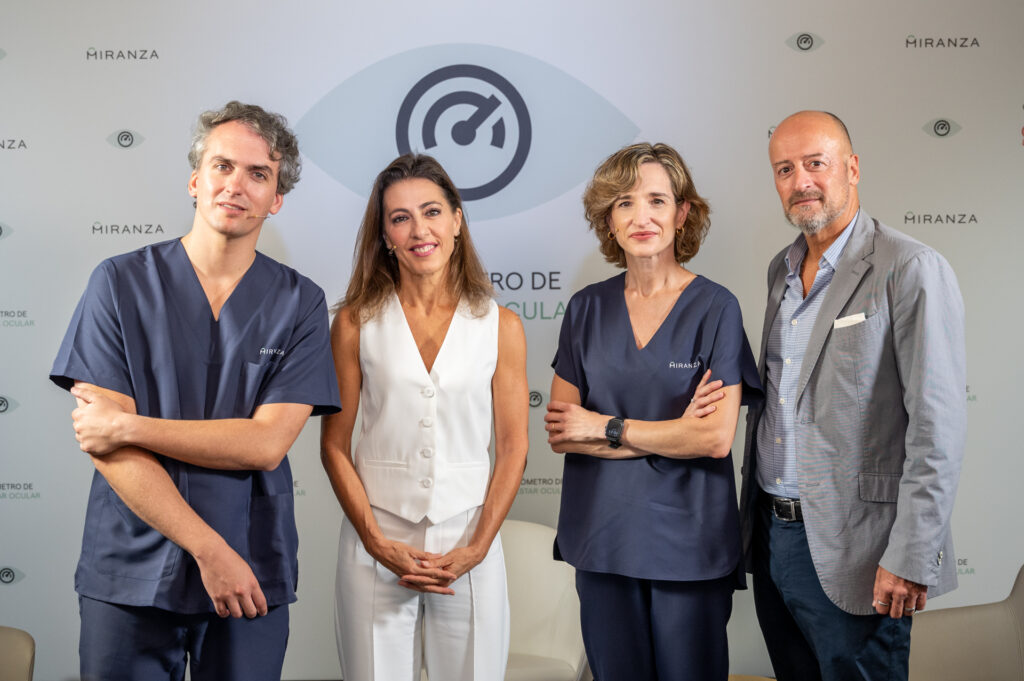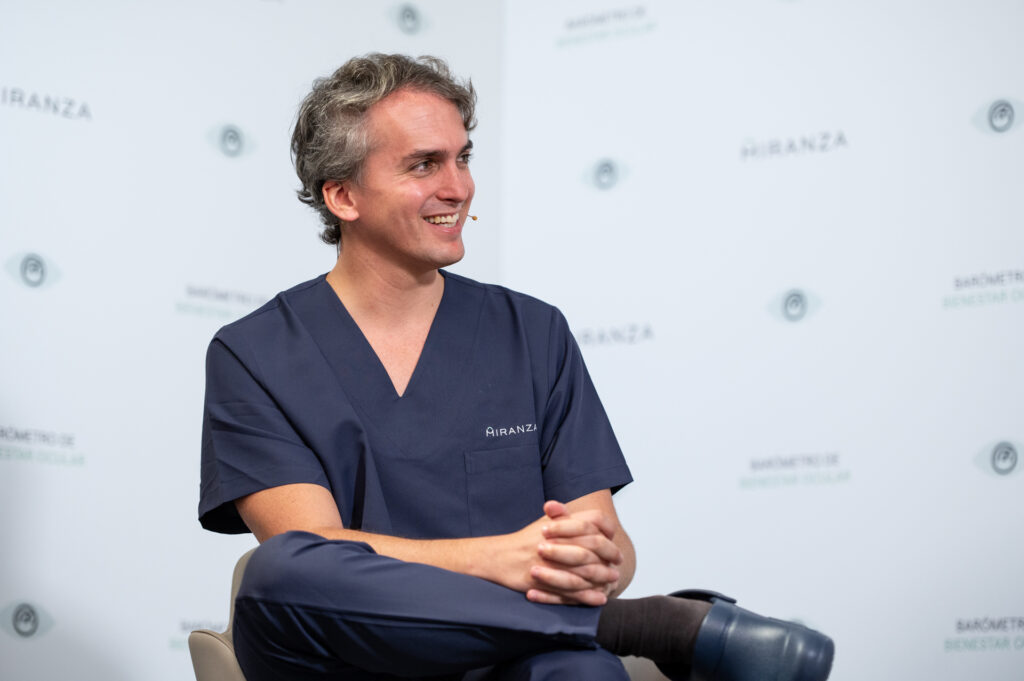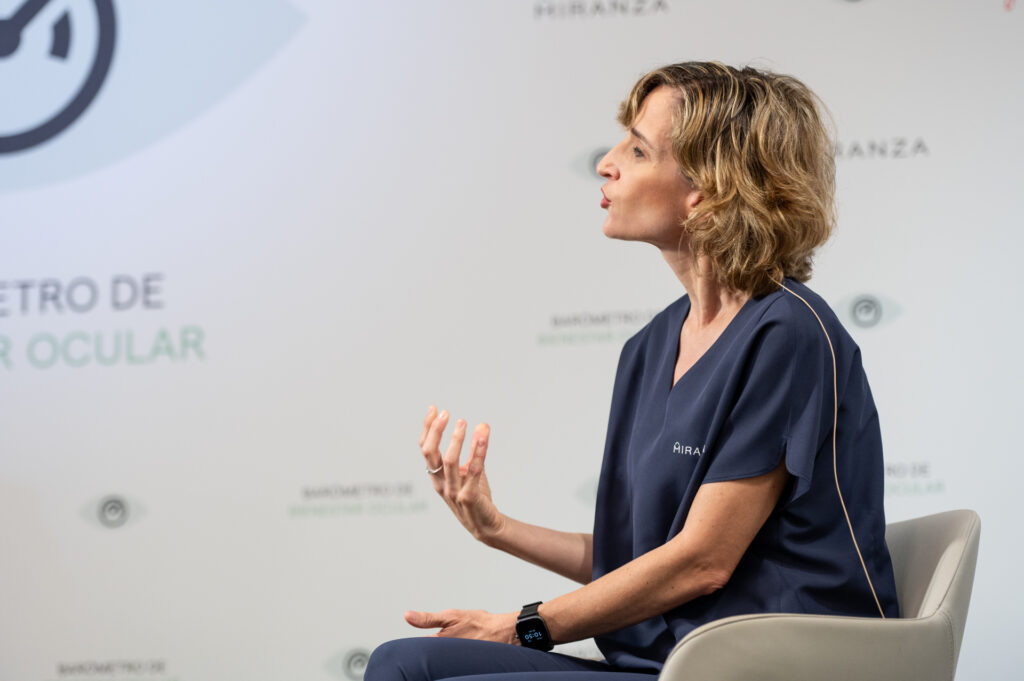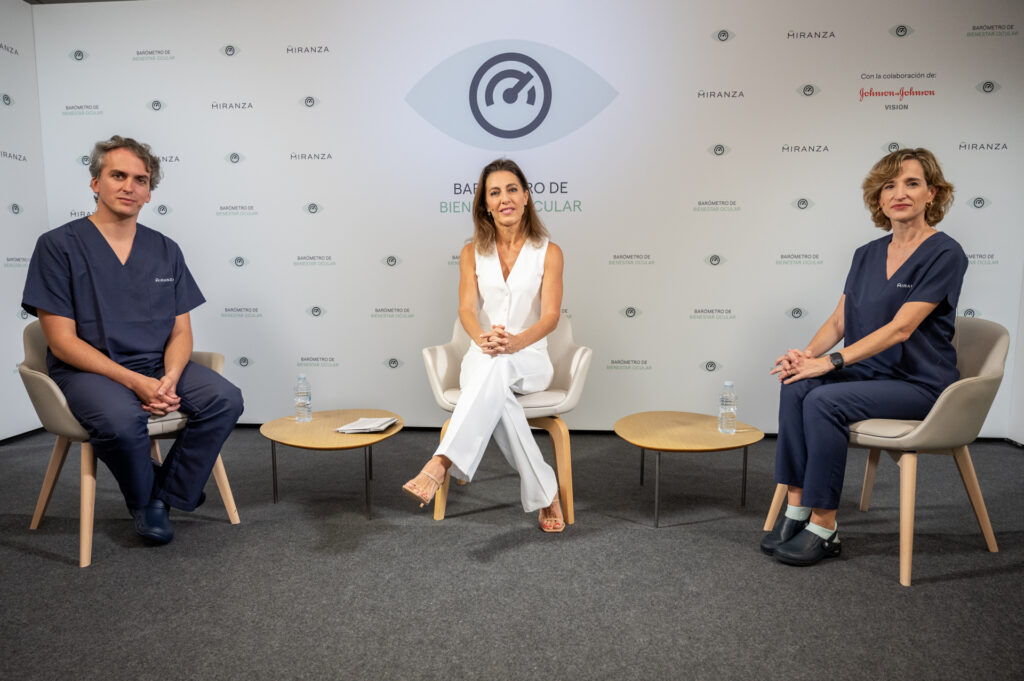
Stress: an epidemic that also affects our eyesight
On the occasion of World Sight Day (12th October), we are presenting the 3rd Eye Wellness Barometer.
Although seven out of every ten people believe that eyesight enables us to enjoy life more fully, eye health and wellness only just makes the grade.
The 3rd Miranza Eye Wellness Barometer, based on a survey of one thousand people, was announced today in Madrid by Dra. Itziar Martínez Soroa, ophthalmologist at Miranza Begitek (San Sebastian), and Dr. Jorge Alió del Barrio, ophthalmologist at Vissum Grupo Miranza (Alicante), at an event presented by the journalist and newsreader Ángeles Blanco.
It was revealed during the presentation that, despite how important we believe our eyesight to be for enjoying life, according to the index included in the study, our eye wellness only just makes the grade with 5.22 out of 10, which is almost the same as last year. Although most of those surveyed – 75% – see their eye health as “reasonable”, the percentage drops to 33% if only those who believe it to be ‘good or excellent’ are included.
Strangely enough, despite the fact that our eyesight plays a leading role in enjoying life, our eye health suffers whenever life is burdened with stress and anxiety, thus entering a vicious circle that prevents both eye and life wellness. According to the Barometer, those who acknowledge suffering from stress or anxiety (half of those surveyed) are also one of the groups that least values their eye health. With this in mind, Dr Alió del Barrio explains that “we are currently suffering the consequences of two epidemics that have had an impact on eye health and wellness, and one of these is anxiety and stress that, as well as directly causing certain diseases such as central serous chorioretinopathy, which affects the retina, lead to a greater risk of diabetes, sleep problems, food disorders and migraines. All this has repercussions on eyesight and makes processes such as dry eye even worse…It’s a vicious circle”.

50% of the population, short-sighted by 2050
The second great epidemic to threaten eye health and wellness in the Spanish population is the abuse of screens, which increases childhood myopia, accommodative spasms, particularly among people with presbyopia or eyestrain, and dry eye, especially with menopause.
According to the Miranza specialist, “it is calculated that 50% of the population will be short-sighted by 2050. This should be of concern, as this refractive error is not only a prescription problem but leads to a greater risk of retinal disease and glaucoma”. The ophthalmologist advises taking visual breaks, looking into the distance and increasing outdoor activity, and highlights treatment with atropine eye drops to slow down myopia, particularly in childhood.
For her part, Dr Martinez Soroa explains that “the relationship between dry eye and screens is primarily due to reduced blinking when focusing on the screen, as the eyelids work like a car windscreen, and exposure of the eye alters the tear film and the ocular surface”. The doctor advises obtaining a precise diagnosis, as “it is a multi-factor disease that requires a personalised approach for which, beyond the use of artificial tears, we now have applied technology such as pulsed light with which we are able to control the symptoms of this growing eye syndrome more effectively”.
The “age of the scare”
Another of the results of the study shows that 82% of those surveyed aged between 41 and 64 confirm being concerned about their eyesight and are more aware of the need to look after it (93%). Despite this, although 8 out of every 10 people generally believe they should have their eyesight checked every year, the average number of check-ups does not actually reach one per year.
With regard to the greater degree of concern and the poor perception of eye wellness in those aged between 41 and 64, Dr Itziar Martínez Soroa confirms that the 40s are the “age of the scare”, when initial eyesight problems begin for many people, with the appearance of presbyopia or eyestrain, which is also something that occurs during a fully active and extremely demanding period of life in work, family and social realms”.
Another group who were more pessimistic than the rest with regard to their eye health are those who wear glasses or contact lenses. This group also suffers the discomfort associated with the use of vision correction, particularly from contact lenses. To this end, Dr Jorge Alió del Barrio explains that “on one hand, it is quite normal for people who use vision correction to be more pessimistic about their eye health, as they are aware that they require assistance to see properly and function, and this feeling of dependence makes a difference”.
“Furthermore”, adds the ophthalmologist, “there is a certain amount of risk for some contact lens wearers who do not use them correctly, either wearing them for too long or not taking care of them properly, etc., of suffering corneal infections”. The specialist therefore warns that “it is important to be very careful with contact lenses and to ration their use, and remember that there are alternatives for adults, such as refractive surgery, which have a lower risk of infection”.

Can we avoid sight loss?
The 3rd Miranza Barometer also reflects that over half of the Spanish people surveyed in any age range believe that sight loss cannot be avoided (only 4 out of every ten believe it can be). According to the experts, this belief may be due to the fact that the population does not link their lifestyle too much with their eye health and their schedule of eye check-ups, and that the major advances currently available to solve eye problems, such as minimally invasive surgeries for refractive surgery, cataracts and presbyopia with premium lenses, lamellar cornea transplants, devices for glaucoma, advances in AMD with injections of new medications and applied technology to treat dry eye, among others, are not well known.
One of the most noteworthy conclusions of the study is precisely the lack of awareness of the relationship between lifestyle and eye health and wellness. Although a certain relationship with heredity, pollution and the weather is observed, all of which are external factors, “its relationship with habits that depend entirely on oneself, on one’s choices and, to a great extent, on one’s willpower, such as smoking, food and physical exercise, are not known or, perhaps, do not want to be admitted”, explain the Miranza specialists.
Symptoms and diseases
The study also indicates that at least one-third of Spaniards suffer from symptoms of vision-related problems. In order of frequency, the most common are sensitivity to light, blurry vision, the sensation of failing eyesight and irritation, itching or burning, and dryness in the eyes.
Furthermore, astigmatism, presbyopia and myopia head the ranking of diagnosed eye diseases. Figures received by Miranza through a clinical study conducted at the same time on over 700 patients on their first visit to 15 of its centres confirm this data.
According to Dr Ronald Sánchez, R&D coordinator for Miranza and head of the clinical study, it was seen that in 73.3% of the patients evaluated during a first ophthalmological visit and who suffered from some degree of eye disease, the most common disease is refractive error (80%), followed by presbyopia (49.3%), cataracts (21.3%), and dry eye (9.3%), AMD (7.8%) and glaucoma (5.5%). The study adds that 24.4% of these visits require topical or systemic medical treatment (drops, injections or tablets) and that 32.8% would require surgery, mostly cataract (14.3%), followed by laser refractive surgery (7.3%) and intraocular lens surgery (2.3%).
